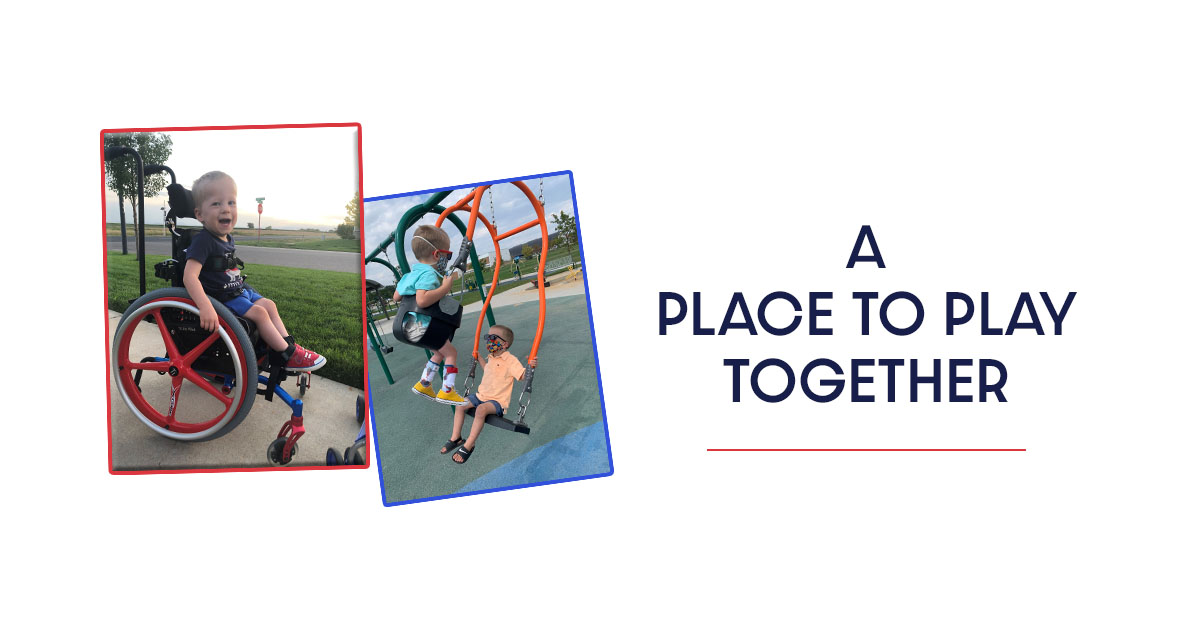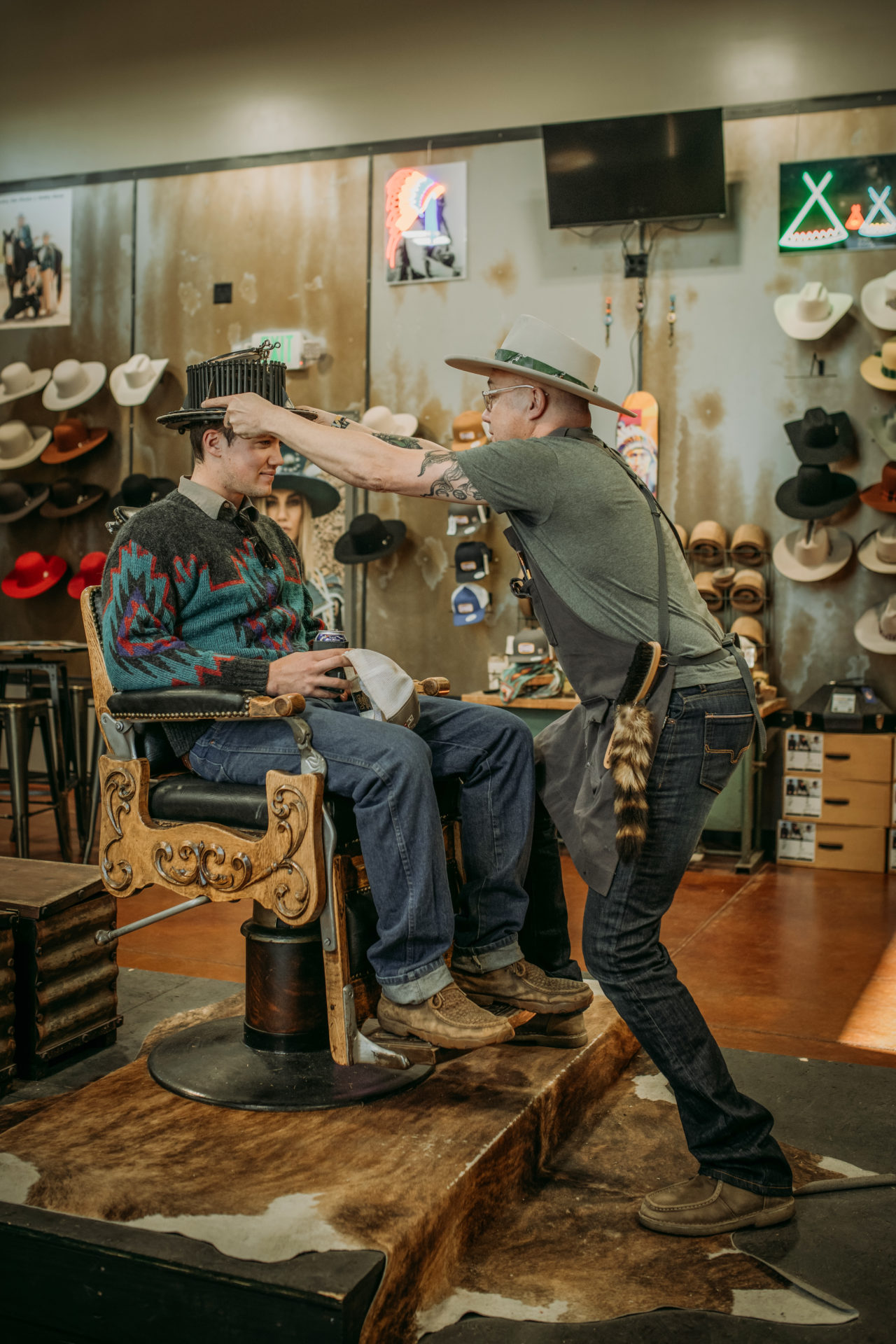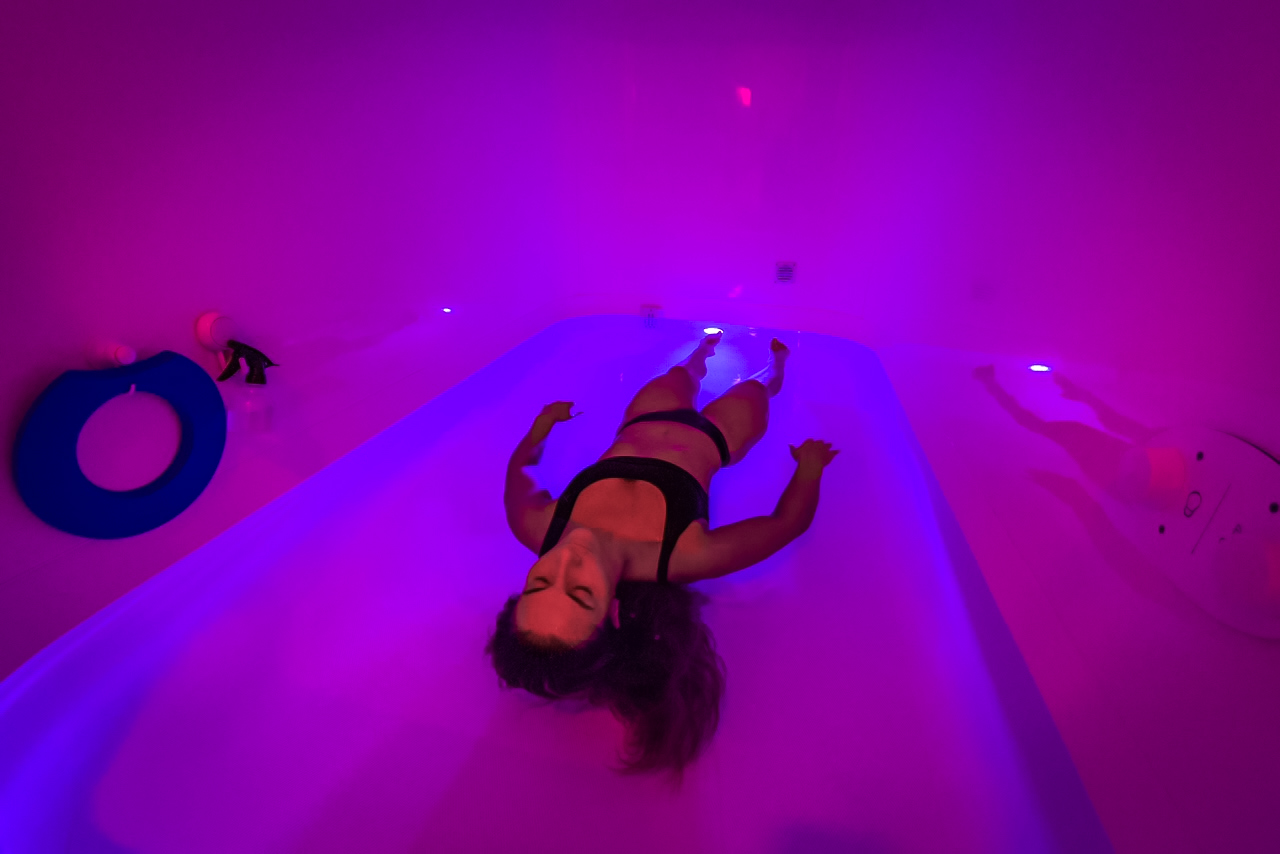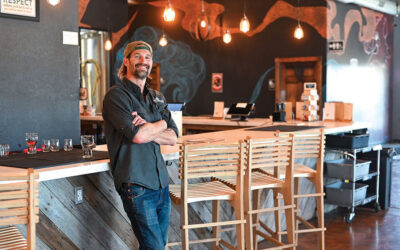As Lauren Bowling works through the long list of daily chores that come with being a mother of three young boys, she’s accompanied by the song that most parents hear a little too often, like a Taylor Swift tune: “Mom, Can We Go to The Park?”
Neighborhood parks act as a haven for harried parents because of the way they burn their kids’ energy while somehow recharging their own, and Bowling visits them as often as she can. But a trip to the park isn’t a walk down the block for Bowling, as least not when Miles, one of her twin boys who will turn 5 in a month, asks to go. He’s not talking about Berthoud’s neighborhood parks. He wants to go where he can have fun.
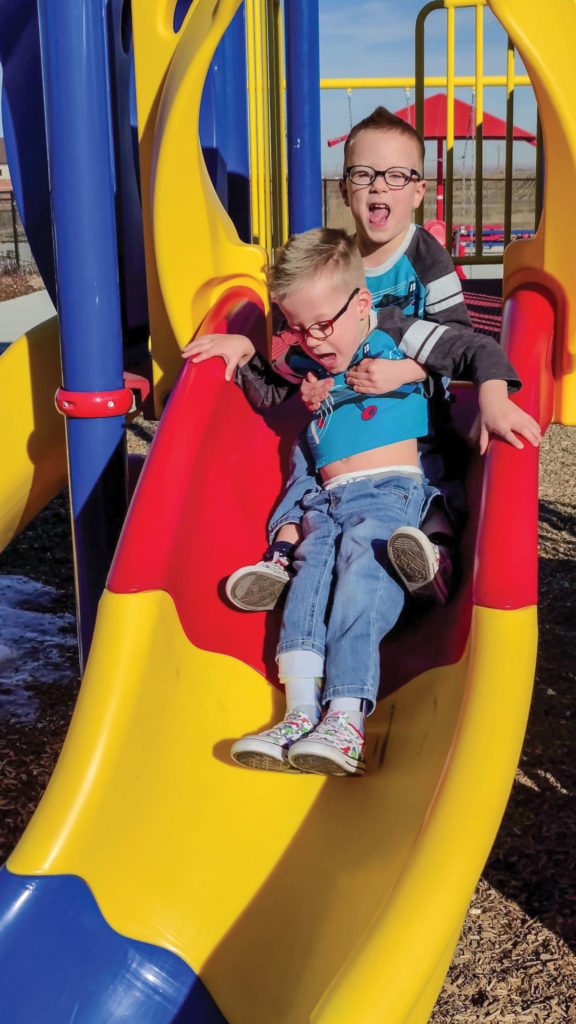
Miles goes down a slide with his twin brother, Mack, at an adaptive playground. Adaptive playgrounds
allow kids with disabilities and able-bodied children to play together. Photo courtesy of Lauren Bowling.
Miles has cerebral palsy as the result of complications from Twin Transfusion Syndrome, which left him without oxygen long enough during delivery to result in a traumatic brain injury. Lauren and her husband, Richard, consider Miles and his twin, Mack, walking miracles, which is something you hear a lot about with difficult pregnancies, but this time it fits.
Miles and Mack were week to week just 12 weeks in, Lauren says, until doctors induced labor three months early. They scrapped and survived, and Mack is as able-bodied as they come, and Miles has no cognitive problems, which gives the Bowlings oodles of gratitude. It really should have been much worse.
But Miles does need a wheelchair to get around. The neighborhood park, and most other parks in Northern Colorado, means he watches his brother Braxton, 5, and Mack play on the equipment while Lauren pushes him on the sidewalk. She does what she can. She races around and will even carry him so he can go down a slide, his favorite activity, but he’s 40 pounds, and she sings the song of all parents of young children: “I’m tired.”
Fun, for Miles, then, is 40 minutes away at an adaptive park, which as parents will tell you, is an outing, not a simple trip to burn a couple hours. For outings, boys that age need snacks, entertainment, planned potty stops, water and a bag filled with extra clothes and other supplies for whatever mess they get into. The time in the car is equal to most Marvel movies and doesn’t give Lauren a chance to unwind herself: If anything, it’s the most stressful part of the day.
But adaptive parks have surfaces he can roll on and swings and zip lines he can strap into. He can play next to his brothers. He can be a boy. So, he asks “all the time,” Lauren says, to go to the park, and you can hear the weariness in her voice in response to that song, both because of the distance and because sometimes she has to tell him no. A trip to the neighborhood park sometimes makes it worse.
“He’s basically a 5-year-old who knows exactly what he wants,” Lauren says. “He wants to follow his brothers, and he can’t make his body do it. That can be very frustrating and difficult for him.”
Lauren shares her story because that’s how adaptive parks get built, and she desperately wants one for Miles. Many major cities in Colorado already have one, including Greeley and Fort Collins, and in fact, not just one but three parks are within that 40-minute drive, in different directions. Putting one in Berthoud would probably make the town of around 10,000 people the smallest to have one.
Regardless, seemingly everyone is on her side, including the town, and the Berthoud Adaptive Park Project is led by Can’d Aid, a nationally recognized nonprofit that provides opportunities for underserved youth. No one dislikes the notion of providing a playground where children with disabilities can play with their peers, and many are wonders that offer fun, colorful equipment that able-bodied kids enjoy, too.
“That’s the key,” Lauren says. “That’s what makes it so wonderful. The other kids don’t notice that the equipment is different, and that’s what is so monumental. They’re playing side-by-side together.”
The bummer, of course, is the cost. The Berthoud park will cost an estimated $800,000. Lauren would like to see the park built by the end of this year, but worst case, she says, would be 2023. As of March 1, the project had raised $18,000, according to the website, but that money does not include a matching donation of $100,000 by Edwards Development, the original developer of the neighborhood where the park would be located. Cost, as it usually is, is the biggest reason why more adaptive parks aren’t built.
“You slap ‘ADA’ on anything, and they charge you three times as much,” Lauren says. “They’re just so expensive. It’s why the towns are not putting in these parks or this equipment. But it’s so important.”

Miles and Mack swing at an adaptive playground. The swing allows Miles, who has cerebral palsy, to strap in and be safe while his able-bodied twin plays alongside him.
Fight for their right
Many parents of disabled children learn early on to fight, and many times the goal is the same: They want their child to be included. This, more than anything, is why adaptive playgrounds exist.
Juliet and Jason Dawkins are parents to Lucia, who they call LuBird. She was born with Pallister-Killian Syndrome, a disorder that affects LuBird “from head to toe,” Juliet says.
Lucia has weak muscle tone, intellectual disabilities and other issues. Lucia loves to swing, and that’s how they got started with LuBird’s Light Foundation, which operates mostly in the Denver area. LuBird is now 11, and even a decade ago, accessible playgrounds meant disabled children could visit the park by wheeling up a ramp and being around other kids as they ran by them.
“Now people are realizing that accessible is not inclusive,” Dawkins says. “Even if you have a smooth surface, a wheel-able surface, if you don’t have a piece of equipment for them to play on, what’s the point?”
Their foundation builds inclusive playgrounds and works with Denver Parks and Recreation for ideas, and its jewel is LuBird’s Light Playground at Stanley Marketplace in Aurora, which opened just a couple years ago. The playgrounds typically feature slides with slopes or ramps that lead to equipment instead of ladders, sensory equipment such as rocks with different music tones, a non-invasive barrier of some kind to keep kids in, maybe a trampoline (yes, kids in wheelchairs can bounce), a spinner built for wheelchairs and zip lines.
But they’re also fun, and most able-bodied kids who visit adaptive playgrounds (which is not only allowed but encouraged, as that’s the whole idea) see them as unique places to play with cool stuff: Miles’ brothers, for instance, love to visit the adaptive playgrounds almost as much as Miles.
There are loads of ideas, and many are expensive because of the additional anchoring they need to keep kids safe, Dawkins acknowledges. There aren’t many adaptive playgrounds along the Front Range as a result. Coloradoparent.com lists seven in the Denver area with varying definitions. Fort Collins has Inspiration Park, and Greeley has Aven’s Village. Namaqua Park in Loveland is ADA accessible and has some sensory play.
This is why it usually takes fundraising efforts led by passionate people to get one built. These are usually parents, but a church in Greeley led the drive to build Aven’s Village after the lead minister of Journey Christian Church, Arron Chambers, wanted to do something for Aven Mondy, who was 7 when the park opened in 2016 and whose parents belonged to the church.
“The city had an idea for years to do this, but the cost was $1.3 million,” Chambers says, “and the city asking for that money was different than private citizens.”
Chambers had not heard of an adaptive playground in 2013 when he began to work on the idea: He just wanted to give Aven a place to play. He brought in other kids for help with design. Now it’s one of the more popular playgrounds in Greeley.
“The city took a lot of pride in it,” Chambers says. “We wanted a place where kids could play together, and I think that’s what has happened. We were honored to be a part of it.”
These days, the idea of adaptive playgrounds continues to grow. When Dawkins went shopping for equipment for LuBird’s park, many of the pieces weren’t even a year old, which demonstrates how new ideas have flourished. Shane’s Inspiration, which designed and helped build Inspiration Playground in Fort Collins, designed Aven’s Village as well and has built more than 75 playgrounds throughout the world.
“Ideally, all playgrounds would be inclusive,” Dawkins says. “They would just be playgrounds.”
Getting there, however, has taken some compromise.
Piece by piece
Playgrounds are generally expensive, not just inclusive ones, and that’s nudged organizations such as LuBird to shift strategies a bit.
“I think rather than demand all playgrounds be redone, adding an inclusive element is the next best thing,” Dawkins says.
The easiest thing to do, she says, is to swap out swings. Inclusive swings are relatively cheap and still offer a great opportunity for children to play together.
“Swinging is awesome and can be calming for children with mobility issues,” Dawkins says. “That should be at the top of every list. Two is better.”
Lauren, Miles’ mother, says she’s seeing more communities adding elements as well rather than build an entire park. A popular choice is smooth surfaces instead of wood chips.
“It’s a step in the right direction,” she says. “It’s helpful. We do choose parks with a rollerable surface at least.”
But there are downsides to that thinking: It may mean those surfaces replace the idea of entire, adaptive playgrounds like the one she wants to build in Berthoud.
“It’s hard to tell a 4-year-old that you can roll right up to the equipment, but you can’t do anything past that,” she says. “That’s not fun for him. It’s helpful, but we’ve got to do better, as a community and as a human race.”
Adaptive playgrounds aren’t just for children either, Dawkins says. More adult organizations are supporting them because parents with disabilities or older seniors who, say, have a walker, like to be on the playground with their grandchildren. Will Edwards, the owner of Edwards Development, donated the large, matching sum to the project because his father grew up in Berthoud and he thinks it would be great for the town. The playgrounds are known to attract tourism, which could be good for Berthoud as well.
“We wanted to distinguish ourselves by providing amenities that many developers glossed over,” he says. “We wanted something cool for the park, but we didn’t know what that was until we met Lauren. She deserves most of the credit. She started talking to me about adaptive parks and it was an ‘ah ha’ moment for me. I knew it was something we should do.”
Lauren says without the playgrounds, a “huge spectrum” of our population may not get to experience the joy of having fun together. This is why Dawkins pushes for adaptive playgrounds as well.
“There’s a sense of community on a playground,” Dawkins says. “There’s no better place to socialize and learn from each other.”


